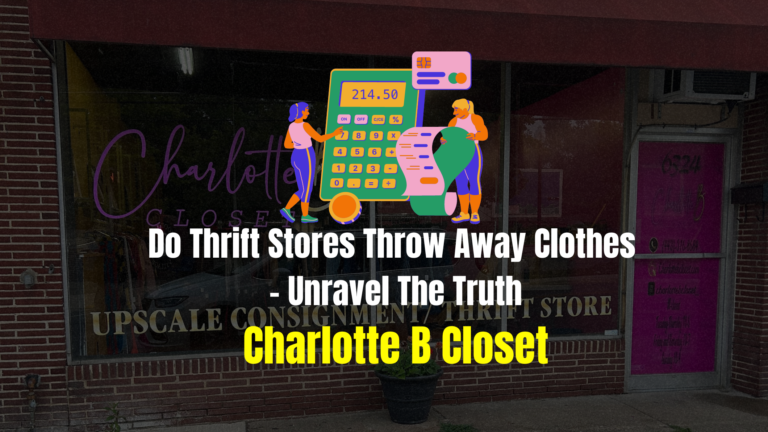Do Thrift Stores Pick Up Furniture? | Answer by Thrift Store Owner
Have you ever been overwhelmed by unused furniture, wondering how to repurpose it for a greater cause? You’re not alone.
Many individuals contemplate donating to thrift stores but are deterred by the daunting task of transportation.
The question on many minds is, do thrift stores pick up furniture?
Yes, several thrift stores provide furniture pick-up services. However, the service’s availability often hinges on the store’s location and individual policies. Always reach out to your nearby thrift store to get precise details on their pick-up options and timing.
Do Thrift Stores Pick Up Furniture – Short Guide
Yes! Many thrift stores extend the service of picking up furniture from donors. This initiative aims to ease the donation process, especially for bulky or numerous items. While many establishments are ready to come to your doorstep, it’s essential to know that this provision isn’t universal.
The service largely depends on the store’s operational policies and its geographical location. A quick call or email to your local thrift store is recommended for the most accurate and up-to-date information.
Not only does this proactive step provide clarity, but it also ensures you’re well-prepared for a smooth donation process. Remember, your generous act goes a long way in supporting charitable causes and providing affordable furniture options for others.
Furniture Donations Made Easy: Thrift Store Pick-Up Services
The thrift store industry has evolved significantly over the years, adapting to the needs of the community. While many thrift stores offer furniture pick-up services, it is essential to understand that this provision is not a given for all.
The availability of pick-up services largely hinges on the particular store’s location and its specific operational policies. For instance, a thrift store in a metropolitan area with ample resources might be more equipped to handle pick-ups compared to a small establishment in a rural setting.
Recommendation
To avoid any confusion or potential inconvenience, it’s imperative that you reach out to your local thrift store before making any assumptions about their pick-up services. This proactive approach not only ensures that you receive accurate information regarding their pick-up services but also helps in understanding any associated scheduling or terms. Remember, a quick phone call or email can save you a lot of time, even if it’s Sunday, a potential hassle.
Thrift Store Furniture Donation Policies
Donating furniture to thrift stores is a wonderful way to give back to the community while also ensuring that your old items find a new purpose.
However, before loading up your vehicle with furniture to donate, it’s essential to understand the specific policies that different thrift stores might have in place. These policies are essential to ensure that the donations are beneficial for both the donor and the thrift store.
Let’s delve deeper into the general policies, item conditions, and restricted items that most thrift stores consider.
General Policies
Thrift stores, much like any other establishment, have a set of guidelines that they adhere to. Their charitable nature doesn’t exempt them from maintaining a certain standard when it comes to accepting donations.
Every item they receive goes towards fulfilling their mission – whether it’s supporting a cause or providing affordable options to the community. To achieve this, they have to ensure that the items they resell are of a certain quality.
Thus, while every donation is appreciated, there are checks in place to ensure that the items align with the store’s quality standards. This meticulous approach helps the stores maintain their reputation and guarantees that customers walk away feeling they received value for their money.
Item Condition
The condition of an item is often the make-or-break factor when it comes to its acceptance. Thrift stores tend to gravitate towards furniture in good condition.
A ‘gently used’ tag is ideal, indicating that the item, while not brand new, is still in a state that’s fit for use. Minor wear and tear might be acceptable, but furniture that’s heavily damaged, stained, or missing essential parts might not make the cut.
The rationale behind this is simple. The items on the thrift store shelves should be things they can confidently resell, ensuring the proceeds go towards supporting their various charitable endeavours.
Restricted Items
It’s not uncommon for thrift stores to have a list of items they do not accept. This isn’t a reflection of the item’s value but more about practicality and safety.
Mattresses, for example, due to potential health and hygiene issues, might not be accepted by all thrift stores. Similarly, furniture that’s broken or poses a safety risk might also be on the non-acceptable list.
Before making a donation, it’s wise to reach out to the thrift store to get clarity on any items they might not accept. This small step can save both the donor and the store valuable time and effort.
How to Arrange Furniture Donation Pick-Up?
Donating furniture is a noble act, but the logistics behind ensuring your furniture reaches its intended destination can be a tad overwhelming. Here’s a step-by-step guide to help you navigate this process seamlessly:
Contact
Before anything else, reaching out to your chosen thrift store is paramount. Each thrift store might have its unique set of guidelines and preferred methods of communication.
Whether it’s a direct phone call, an email, or filling out a form on their official website, ensure that your initial contact is clear and concise. Detail the items you wish to donate, their condition, and any other pertinent information. Remember, this step sets the stage for the entire donation process, so clarity is key.
Scheduling
After your donation is green-lit, the next hurdle is figuring out the logistics. Coordinating a time that’s convenient for both you and the thrift store can be a delicate balancing act.
However, most thrift stores are accommodating and will collaborate with you to set a date and time that causes minimal disruption. Some stores might have specific days dedicated to pick-ups, while others might operate on a more flexible schedule.
Whatever the case, open communication ensures this process is smooth.
Documentation
The act of donating is rewarding in itself, but having tangible proof of your donation serves multiple purposes.
Always insist on a receipt once your furniture is collected. Not only does this serve as a personal record of your charitable act, but it can also come in handy during tax season. In many jurisdictions, such donations are tax-deductible, meaning you could get a reduction based on the value of the items donated. Keeping this receipt safe could save you money in the long run.
Preparing Furniture for Pick-Up
Donating furniture isn’t just about setting it outside your door and waiting for it to be picked up. A little preparation goes a long way in ensuring that your donation process is smooth and that the furniture is in the best condition possible:
Cleaning
First impressions matter. While thrift stores are accustomed to receiving items in various states, taking a few moments to clean and sanitize your furniture can make a significant difference.
Wipe down surfaces, vacuum upholstered items, and ensure that all items are free from dust and grime. This step not only increases the item’s resale value but also shows consideration for the next owner.
Dismantling
Some pieces of furniture, especially the bulky ones, might be easier to transport when dismantled. If you believe this is the case with your donation, consider breaking it down.
However, it’s crucial to ensure that all parts, screws, and, if possible, assembly instructions are kept together. A piece of furniture is of little value if it cannot be reassembled by its next owner.
Safe Storage
In the interim, between deciding to donate and the actual pick-up, your furniture should be stored appropriately.
Find a safe and accessible location, free from potential damages like water leaks or pests. This ensures that the item remains in its donated condition and makes the pick-up process efficient for thrift store personnel.
After all, the easier you make it for them, the more likely they are to accept future donations from you.
Conclusion
Donating furniture is more than just a kind gesture; it’s a sustainable choice that benefits the environment, supports local communities, and provides a second life to items that might otherwise be discarded. With many thrift stores now offering pick-up services, the process has become even more accessible.
All it takes is a little preparation and understanding of the store’s policies. So, the next time you think of replacing that old couch or dining table, remember there’s a thrift store out there that might gladly take it off your hands.
FAQs
What factors influence thrift stores to offer furniture pick-up services?
The availability of furniture pick-up largely depends on the store’s resources, location, and operational policies, with metropolitan-based stores often having more capabilities.
Are there any fees associated with furniture pick-up by thrift stores?
While many thrift stores offer free pick-up services, some might charge a nominal fee based on distance or the size of the donation. It’s best to inquire beforehand.
Can I schedule a furniture pick-up during weekends or after work hours?
Scheduling flexibility varies across thrift stores. Some offer weekend or after-hour services, but it’s advisable to discuss and confirm timings directly with the store.
How can I ensure my furniture donation is accepted for pick-up?
To increase the likelihood of acceptance, ensure the furniture is gently used, clean, and free from significant damages. Always check with the store about any restricted items or specific guidelines.

Hi there, I’m Toni Whitten, but you might know me as LadyT. I’m a passionate entrepreneur and the proud owner of Charlotte B’s Closet, your go-to thrift store and upscale consignment.
Outside the store, I connect with the amazing women in my exclusive Facebook group, Housewives of Baltimore, boasting over 23k+ members.
In my free moments, I channel my passion for sharing genuine insights and helpful guides on various concerns through my blog at charlottebcloset.com.







